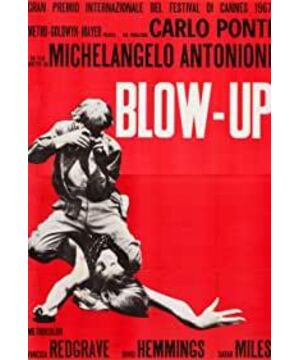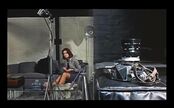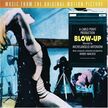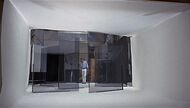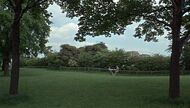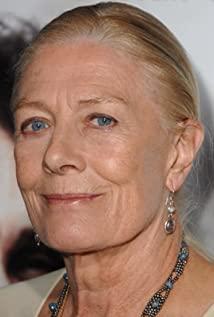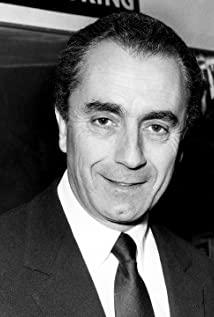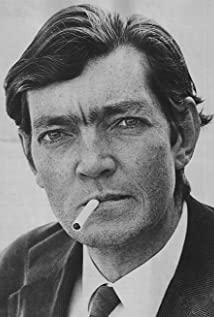But I have never been confident in analyzing the works of the masters, and I feel that my knowledge is shallow and I am blaspheming something sacred. But still want to try it out as my first step across. It's far from enough to see, so I'm limited to what I understand and what I can express.
In Antonioni's eyes, the modern European cities are always dilapidated and barren. The process of modernization has swallowed up people's spiritual world and made people's spiritual barren. Most of the female images in the film are empty-eyed, in a trance, wandering helplessly in the city streets and modern buildings, longing for love but losing the ability to love, longing to escape from the icy environment, and finally tragically trapped in the existing environment and status recognition.
"Zoom" is no accident, it still follows the consistent style of directors in the 1960s, and at the same time, it presents a world that cannot be redeemed.
The story is about Thomas, a commercial and freelance photographer with a reputation in the industry. One day, when he was caught in the dilemma of studio shooting, he took the camera to the park and secretly photographed a couple's love scene. The heroine in the photo was so angry at Thomas's candid shooting behavior, she tried to get the film back, and followed Thomas to his studio. After developing the photo, Thomas found that there was a premeditated murder hidden under this seemingly quiet and beautiful picture by arranging and combining the photos and zooming in on the details.
The film first follows the director's usual color tone: gray. European cities are divided into two completely different scenes, people go to high-rise buildings that are empty and square, and dilapidated buildings that are swept away by the autumn wind. Both scenes are cities in the director's eyes. High-rise buildings are superficial and the most well-known and beautiful side, while depressions are subjective, more of which is the barren and barren externalization of people's inner world. Therefore, one side is the external world. The other side is the inner world.
Opposition of color and black and white: In the formal system of "Zoom", besides the environment, the main and pivotal aspect of the form that distinguishes the external world from the internal world is the opposition of color.
The color space of the inner world and the outer world
film is divided into two types, one is the black and white world representing Thomas' inner world, and the other is the color world representing the outside world of the city. The black-and-white world, as Thomas' subjective main world, occupies most of the space, and the external color world is interspersed out of place and abruptly when Thomas is driving on the road.
The significance of the black-and-white world to Thomas lies first and foremost in his absolute control. Thomas's studio tone is like his photo works, basically in black and white. In his black and white world, he has absolute control over everything, can call assistants and models at will, and unscrupulously release his violence. temper. The most typical scene, when two young girls with model dreams asked Thomas to take pictures for them, Thomas jokingly said: "Take up a little time? I don't even have time to cut my appendix." At this time, he picked up the A coin toyed with applause. Economic strength, as a measure of individual and even national strength, has also become a tool for declaring sovereignty. There is also a similarity in a song and dance segment of "Sing in the Rain" (oh hahaha~).
If money is just a tool for Thomas, the camera is the real offensive weapon. The novel "The Unbearable Lightness of Life" has such a description: "Sabina took the camera from Teresa, and Teresa took off her clothes. She was standing, naked and defenseless. The reason why I said defenseless, Because the camera he used to cover his face was taken away, she used to target Sabina like a weapon. Now, she's at the mercy." The camera itself is documenting, holding a camera means your image rights are in your hands. I have it, and I can make subjective judgments about it to get what I want without your consent. So in the film, Thomas's black-and-white studio world is his own centralized world.
But as soon as he leaves black and white and enters color, Thomas loses this control, and instead looks more like an unborn child, and all kinds of colors seem to be full of novelty in his eyes. The first time I traveled, the pictures of buses of various colors on the road were partially filled with the whole picture, and the visual impact was strong. On the second trip, the camera used the fixed-focus internal push-pull first. When Thomas's car moved behind the vehicle in front, it quickly fixed-focus and pushed the lens, and then quickly pulled it back. It felt like a child playing a thrilling game on the road. Then there is the panning to show the scenery outside the car, as if everything is worth watching and digging for Thomas.
Peeping and being peeped
As just said, the camera is a weapon for Thomas, and as far as the camera is concerned, as a machine with a recording function, it has strong peeping properties like a telescope. The root cause of candid photography pushing the story to its highest point in the film. After entering the colorful world, Thomas kept searching, and accidentally found a green and peaceful park, where he also accidentally discovered the intimate behavior of a couple. He hides behind a tree and takes pictures one by one, while the camera is still his powerful weapon. However, when the woman in the picture discovered the candid filming and came to stop it, Thomas' peeping at others turned into being peeped. First feel someone following on the road (here's a great subjective shot of the stalker: the shot represents the stalker's subjective point of view, first pans in a fixed position, Thomas enters the picture, walks away, and then the camera starts to follow. This shot appeared very suddenly in the film, and it was used ingeniously), and then I found someone peeping outside the window in the lunch shop, and a "Go away" sign was inserted in the back of the car, and the horn was honked for a long time as a warning. .
The second peep was when Thomas noticed something strange in the photo. The camera starts from a subjective point of view at this time, shaking the selection back and forth between the two photos, indecisive and full of doubts. Soon the lens quickly changed the perspective, jumping from the subjectivity of the protagonist to the subjectivity of an unknown third party. Thomas is squeezed in the middle of the two pictures, and the lens seems to be a pair of eyes hidden behind the pictures, peering through the gap. Here it can be said that this is an objective lens, but because of the connection of meaning, such a perspective is more like a kind of voyeurism (agnosticism) that exists outside the scope of human perception. What the film wants to express: the truth is far away from human cognition Outside the scope, such a third-party perspective is a good confirmation of this point of view. In addition, God's perspective also appears many times in the film. The scene where the male protagonist appears will have God's perspective, and most of the time when he appears, the picture is only of himself. I think the God's perspective here is also the performance of third-party peeping. , whether you are a person hiding in the shadows, or a god in the sky, you are all outside the limited range of human perception.
In the film, the use of switching back and forth between subjective and third-party subjective has appeared many times, and I personally think it is very strange.
The intervention of the color world made Thomas fall into an unknowable dimple, from peeping at others to being spied on by others, from controlling others to being controlled by others. For Thomas, the color world did not belong to him, but it became the reason why he wanted to leave. A theme that is ubiquitous in
reality and appearance films is "visual deceit".
Here the world of real appearance is divided into two worlds by Thomas. Generally speaking, the colored world is the appearance of the world directly presented in our eyes, and it should be the most real to people. But on the contrary, Thomas's color world just hides the truth in the appearance, and black and white only has the possibility of revealing the truth for him. Photography as a visual art relies on people's visual judgment and subjective cognition. Thomas found this quiet and steady picture in the park. First of all, he believed in his eyes, what he saw was real, and then he believed in his subjective expectations. In such a quiet place, such a quiet and beautiful situation should happen. matter. But this is not the case. There is a murder hidden in this tranquility. However, this fact is hidden under the wrapping of color, and it has become a kind of confusion and blindfold. After Thomas walked into the washing room door, the red warning light came on, indicating the ominous omen from the beautiful appearance to the cruel reality. The colored scenes were printed into black and white photos and nailed to the wall naked. Thomas once again used his own subjective judgment to sort the photos imaginatively to form an event with a complete causal relationship (of course, this is still the case). Inaccessible to true judgment), Thomas finds a truth in black and white that he recognizes: his presence prevents a murder. But soon a new real image surfaced, and after the photo was enlarged again, the man was already dead, judging by the vague shape of the coarse particles. He came to the park again at night. In the dark world, the colorless world, the body was still there, and the inference of the homicide was established. At this moment, the black and white world seems to be the real world.
Thomas' pride came to an abrupt end, because soon all reality would be gone from him. During the day, the green park returned to its usual tranquility and peace, and the body had long since disappeared. Photos are lost. The disappearance of the evidence left Thomas deeply desperate. The only remaining enlarged photo of the corpse is just like an abstract painting of a friend, representing nothing and nothing. At this moment, the boundaries between black and white and color are blurred, and the boundaries between reality and appearance are also blurred. Thomas feels like he has been removed from all defenses, and the weapon used to peep at the real image begins to rust and rot within a day. Now he is indeed a defenseless child, without weapons against the world.
Thomas tried to find the woman who stole the photo, tried to convince the publisher that it was indeed a murder, but even he couldn't believe the authenticity of what he experienced, although he came to the park 4 times always inadvertently Looking up at an iconic billboard in the distance, I was convinced that this was the park he had been to, but in the end, objective judgments could not explain the truth, and subjective judgments could not spy on the truth. The real truth is far beyond what people can perceive.
The tragedy of the film unfolds in the final minutes. Thomas frantically snatched a smashed guitar plate in a rock concert. This gave this guitar a meaning within a specific range and a specific group of people. Once it was separated from this specific environment, it lost its meaning and became For example, in the end, Thomas threw the piano board on the side of the road, and passers-by also spurned it. In fact, no one cares what the truth is. The abandonment of the guitar by passers-by symbolizes that people have long ignored the truth. Thomas himself realized that the desire for the truth is just wishful thinking. In a drug party, everyone is nothingness, it doesn't matter where in the depths, it doesn't matter what happens, it doesn't matter what the past is in the future, as long as the psychedelic present is happy in the present. This is the social status quo in Antonioni's eyes. At the end, the publisher stood next to a statue like Jesus, the lights were cast from the top of his head, as if God's call, he called Thomas to join this empty world together. Thomas joined. And finally recognized the real unknowable.
He came to the park again, and the doomsday youths in masked costumes showed up and started a game of tennis without balls and rackets. The camera shot from the reflection shot for the front and back, to the way of throwing the mirror to draw a trajectory of the ball that seems to exist. This is Thomas' perspective, and it is also the director's guide to guide the audience to identify with the authenticity of the game. When Thomas picked up the non-existent tennis ball and remembered it when he heard the sound of the tennis ball, it proved that he had joined this game, and had completely accepted the fact that it was really unknowable, and became a mob like everyone else. Finally, the camera shot Thomas walking on the lawn from a vertical angle, and then Thomas disappeared from the camera, so the director seemed to be jokingly mocking the audience. You thought you were just watching a story, but what you saw might not be true. Thomas may never have existed.
In fact, I don't think it's a movie that is completely telling you the truth and the unknowable. From the scene with the electric guitar, it can be seen that the meaning is for different people in different environments. Thomas has been looking for the real image, but the real image should be what he believes in, not a unified standard. The European city in Antonioni's eyes is the spiritual wilderness. The spiritual barrenness has caused the rupture of meaning, thus forming the "absurd". All the people in it seem to be absurd. Thomas, who has two sides, is always nervous in the photo. Women, young people carnival at the end of the day... There is almost no lighting method with shadows in the film, the faces are always presented naked in the picture, and the space is always bright. But we don't know the details of any person in the play. It's like an illusory society. Pedestrians are walking on the road, but they are just people who can walk. There is no connection between us. The fracture of meaning and the exhaustion of spirit finally make Thomas succumb to this unknowable world and is unwilling to believe in the truth of his convictions. It is the most terrible thing to surrender and compromise.
This movie is so charming. After writing so much on and off, I feel that there are still many points that I haven't been able to write. If you feel bored, it is enough to look at the appearance of the male protagonist. So handsome, my god, so handsome. . . Woohoo so handsome. . .
View more about Blow-Up reviews


